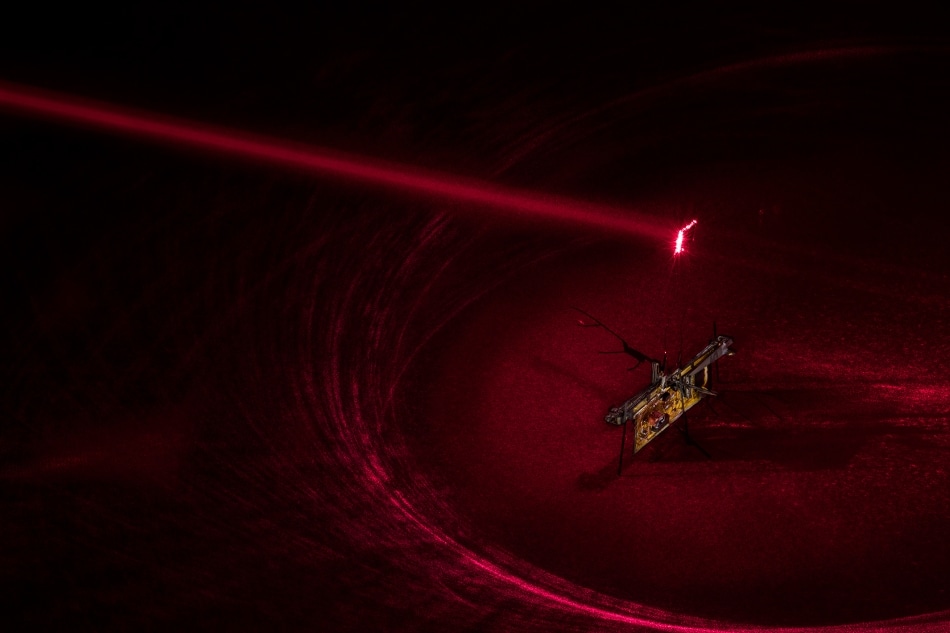May 22 2018
Time-consuming tasks such as detection of gas leaks or monitoring crop growth on large farms can be performed with the help of insect-sized flying robots. Since they are too small to use propellers, such as those fitted on their larger drone counterparts, they fly by fluttering their tiny wings.
 To power RoboFly, the engineers pointed an invisible laser beam (shown here in red laser) at a photovoltaic cell, which is attached above the robot and converts the laser light into electricity. (Image credit: Mark Stone/University of Washington)
To power RoboFly, the engineers pointed an invisible laser beam (shown here in red laser) at a photovoltaic cell, which is attached above the robot and converts the laser light into electricity. (Image credit: Mark Stone/University of Washington)
Their small size is highly beneficial: they can easily slip into tight places that cannot be accessed by bigger drones and are inexpensive to produce. However prevalent flying robo-insects are still restricted to the ground. The electronics required to power and control their wings are too heavy to be carried by these miniature robots.
At present, for the first time, engineers from the University of Washington eliminated wires and included a brain to enable their RoboFly to take its first independent flaps. Although it may be one small flap for a robot, it is a huge leap forward for the robot-kind. The outcomes of the study will be presented by the researchers at the International Conference on Robotics and Automation in Brisbane, Australia, on May 23, 2018.
The weight of RoboFly is marginally more than a toothpick and it is powered by a laser beam. A tiny onboard circuit is used in the robot for the conversion of laser energy into electricity adequate to operate its wings.
“Before now, the concept of wireless insect-sized flying robots was science fiction. Would we ever be able to make them work without needing a wire?” stated Sawyer Fuller, co-author of the study, who is an assistant professor in the UW Department of Mechanical Engineering. “Our new wireless RoboFly shows they’re much closer to real life.”
The flapping was a challenge to the engineers. Wing flapping is a power-intensive process, and it is difficult to incorporate the power source and the controller directing the wings, both of which are huge and bulky, into a small robot. Therefore, the RoboBee, Fuller’s earlier robo-insect, had a tether - it obtained control and power through wires from the ground.
However, it is important for a flying robot to be in a position to operate on its own. Fuller and his colleagues resolved to power the robot by using a narrow invisible laser beam. The laser beam was pointed at a photovoltaic cell attached above RoboFly. The cell converted the laser light into electricity.
“It was the most efficient way to quickly transmit a lot of power to RoboFly without adding much weight,” stated Shyam Gollakota, co-author of the study, who is an associate professor in the UW’s Paul G. Allen School of Computer Science & Engineering.
Yet, the voltage provided by the laser alone was not adequate to move the wings. Hence, the researchers developed a circuit that amplified the voltage of 7 V provided by the photovoltaic cell up to 240 V required for the flight.
The engineers added a brain to enable the RoboFly to have control over its own wings; in other words, they included a microcontroller to the same circuit.
“The microcontroller acts like a real fly’s brain telling wing muscles when to fire,” stated Vikram Iyer, co-author of the study, who is a doctoral student in the UW Department of Electrical Engineering. “On RoboFly, it tells the wings things like ‘flap hard now’ or ‘don’t flap’.”
Particularly, the controller delivers the voltage in the form of waves to simulate the fluttering of the wings of a real insect.
It uses pulses to shape the wave. To make the wings flap forward swiftly, it sends a series of pulses in rapid succession and then slows the pulsing down as you get near the top of the wave. And then it does this in reverse to make the wings flap smoothly in the other direction.
Johannes James, Lead Author & Mechanical Engineering Doctoral Student
As of now, RoboFly can only take off and land. When the photovoltaic cell goes out of the direct line of sight of the laser, the robot is short of power and lands. However, the researchers are optimistic that they can steer the laser very soon such that RoboFly can hover and fly around.
According to Gollakota, although at present RoboFly is powered by a laser beam, in upcoming versions, miniature batteries or energy harvested from radio frequency signals could be used. In this manner, their power source can be adjusted for particular tasks.
Fuller stated that more sophisticated sensor systems and microcontrollers that assist the robots in navigating and completing the tasks on their own could be incorporated into upcoming RoboFlies.
I’d really like to make one that finds methane leaks. You could buy a suitcase full of them, open it up, and they would fly around your building looking for plumes of gas coming out of leaky pipes. If these robots can make it easy to find leaks, they will be much more likely to be patched up, which will reduce greenhouse emissions. This is inspired by real flies, which are really good at flying around looking for smelly things. So we think this is a good application for our RoboFly.
Sawyer Fuller, Co-Author and Assistant Professor in the UW Department of Mechanical Engineering
Yogesh Chukewad, a mechanical engineering doctoral student, was also a co-author on this study. The University of Washington and a student fellowship from Microsoft funded this study.
The first wireless flying robotic insect takes off
Video credit: University of Washington